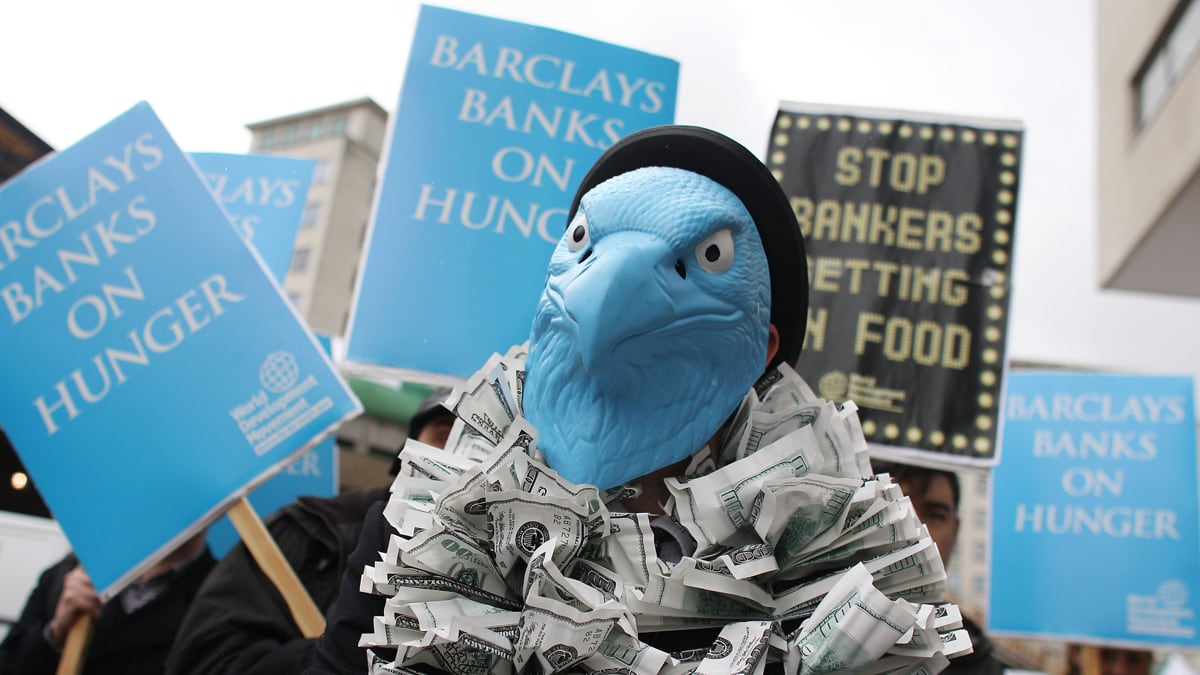Across the pond, a metastasizing financial scandal has now claimed the careers of two of London’s highest-ranking bankers: Marcus Agius, chairman of Barclays, and Robert Diamond, the bank’s CEO. Agius resigned Monday morning, a week after Barclays admitted to illegal interest-rate manipulation and agreed to pay $450 million in penalties. Diamond followed suit this morning.
For all the buzz, it may be hard to see why the Barclays imbroglio matters in the U.S.—and what exactly the bank did to earn record-breaking fines and two top-level departures. But despite all the financial jargon, the scam is far less technical than it sounds, and a version of it is taking place right here at home, for some of the same reasons.
Why? From British indexes to American school districts, banks have more power than ever to twist interest rates in their favor. Throw in traders’ desire to hit good personal numbers by the end of the year—bonus season—and you have all the makings of a multinational scam.
“That culture can breed these kinds of behaviors,” said Bob Barbato, a professor of business ethics at the Saunders College of Business in Rochester, N.Y. “When you dangle incentives in front of people, they find a way to get them. They’re like the squirrels in my backyard: they’ll find any way to get the food. Their IQ goes way up.”
Barclays’ sins centered on a type of international interest rate that most non-day-trading Americans haven’t ever heard of. It’s called LIBOR, the London Interbank Offered Rate, and it’s an average of how much English banks charge to lend money to one another. Though it may sound like a Turkish dessert, these little London numbers have enormous global power. LIBOR is used to set prices on over $350 trillion in securities worldwide—and 90% of all American commercial and mortgage loans are tied to its value. (The city of Baltimore alone has $300 million in LIBOR contracts.) So nudging those numbers just a fraction of a percent could make you billions—and seriously rip off the rest of us.
At the same time, scores of American banks now stand accused of manipulating rates here at home by meddling with municipal-bond auctions. The twin scandals depend on the same factors—insider information and bonus-based incentives—and both teach the same sober lesson: messing with your loan payments is one of the easiest rackets around.

Let’s start in London. You might think that manipulating LIBOR, one of the most important numbers in finance, would be difficult. It’s not. All you need to do is give a barely wrong answer to one question, once a day. Every evening, Thomson Reuters asks a handful of major banks how much they think it would cost their traders to borrow from another bank. They cut out the highest and lowest answers, average the rest, and voilà: LIBOR.
Most major banks have special treasury departments that are in charge of answering that one simple question. But over the last few years, the banks have had two enticing reasons to give lowball answers. The first is self-defense: During the credit crunch, no bank wanted to say how much others were charging them to borrow, which would have revealed baseline risk and rendered them vulnerable to speculative attacks.
The second reason is even simpler: profit. Say you’re a trader at a big bank, and you just sold $100 million in a LIBOR-indexed security to a major American city like Baltimore. The lower LIBOR is, the less you have to pay out in interest. Remember, your year-end bonus is pegged to how much you make for your desk. And you’ll make more for your desk by paying Baltimore a lower rate—a rate which depends on LIBOR.
Now let’s say you work a floor below your bank’s treasury department. Why not walk upstairs and tell your buddy there that you’ve looked at the market and you’re sure you can get low interbank borrowing rates?
Daylian Cain, who teaches behavioral business ethics at the Yale School of Management, says that a scandal like this may not even require conscious corruption—just year-end incentives plus sloppy reporting.
“At the time, they kind of believe their own numbers,” Cain said. “You often won’t register that you’re doing something wrong.” And of course, there’s always fear of missing out. “One of the most perilous thoughts a trader can have is, ‘If I don’t do this, someone else will.’”
It’s well-known that Wall Street’s bonus culture is both cutthroat and zero-sum. A bonus can comprise up to 70 percent of a trader’s compensation, and the competition—stoked by blog posts and barroom talk—is fierce.
“We need to get people to second-guess themselves,” Cain said, “and realize that business is not just a game. It might be a game for them, but it’s my life savings they’re playing with.”
If banks all submit low numbers, as Baltimore alleges they have, they will depress LIBOR, pay less in borrowing fees, make more money for traders, and send them home with fat bonuses. Who loses? Only those with money in a LIBOR-based security: a pension fund, a corporate bond, an interest-rate swap, a home loan. That is to say, almost everybody.
Here in the U.S., we don’t have LIBOR: our banks’ interbank borrowing rate is set by the Federal Reserve. But we still have a lot of financial self-dealing and rate-fixing in the American municipal-bond market, where towns and cities go to borrow money to build schools, hospitals, and bridges. Here the scandal is more local. As Matt Taibbi has reported, for years bankers have been using Barclaysian tactics to cheat local jurisdictions out of billions. Again, the scam depends on inside information and fudging self-reported numbers.
Here’s how it works: When a town wants to borrow money, it usually has an auction to find a lender. Big banks compete to undercut one another with competitive lending rates, and the lowest bidder wins. In a fair contest, the banks keep bidding until the town gets a fair rate. But like a Barclays trader walking upstairs, these banks walk across the street to the other bidding banks, and whisper what numbers they plan to offer. Effectively they say, “We’ll offer 5%, you offer a point higher; next time, we’ll trade places.” By divvying up different loans, the banks can extort artificially high rates.
Most schoolboard officials and city councilmen never knew they were being cheated. It’s a scandal that has already resulted in 15 convictions and $700 million in fines, with cases pending against UBS, Bank of America, Chase, and Wells Fargo.
Again, the individual traders—sometimes thousands of miles away from the towns they buy from—have a huge incentive to share inside information. It can turn a low-paying debt security into a lucrative one, and nudge your desk’s numbers from a sad Christmas to a healthy bonus. And if a trader thinks that “everybody’s doing it,” as Cain put it, “he doesn’t see that he’s putting anyone’s reputation at risk. He doesn’t see his own bias.”
In classical economics, there’s no more common culprit for market failure than information asymmetry. That is, when the guy on one side of a trade knows way more about it than the guy on the other side. In both scandals, all the information pooled in one place: the banks themselves. When Reuters collected LIBOR numbers, it had to trust that Barclays and the other banks were giving good-faith answers. When American towns auctioned off their debt, they had to figure the bidding would be blind. But when the same people who set the rates are the ones that stand to make the most off them, it’s not hard to see why subtle fixing is so alluring.
To top it all off, there’s the element of moral hazard: Those responsible for the LIBOR and municipal bond scandals—a small subsection of shark traders—made short-term gains on their trades which resulted in healthy year-end bonuses. But now, after year’s end, the rest of the bank bears the delayed cost. And by now, those responsible for the wrongdoing may be long gone.
“Many of the individuals concerned in the trader conduct, in particular, are in fact no longer with the bank,” Barclays said in its regulatory statement today. “For certain individuals that remain, we took action to withhold bonus payments pending the outcome of the investigation.”
The fallout goes well beyond the fines. When Barclays announced the fines last Thursday, its shares dropped 17 percent, wiping out almost $5.8 billion in value. (Paradoxically, Barclays’ $450 million settlement with the regulators might be a longer-term victory for the bank, as other major firms—HSBC, JPMorgan Chase, and Citigroup—are being investigated for the same basic crime. Barclays wants to be the first fined, and the first forgotten.)
In the end, the conflicts of interest are the same in London as in Poughkeepsie—and so are the public losses. Bonus boosterism and self-dealing run through both rate fixing scandals. And barring a change in the payout culture, no fine is likely to curb them.





